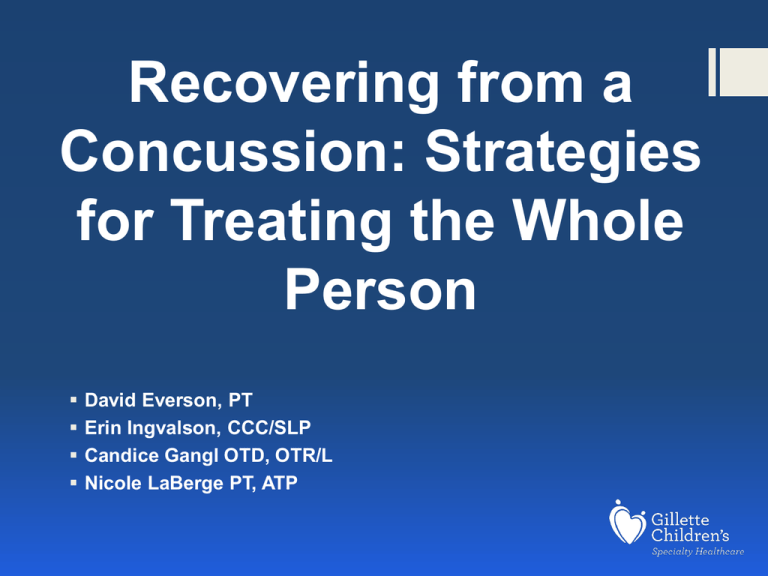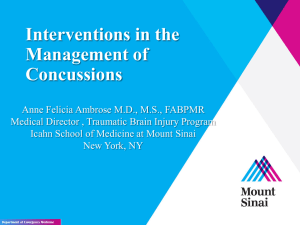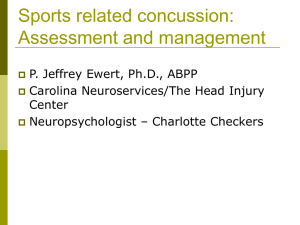Brain. Body. Balance. Managing A Safe Return to Activity After
advertisement

Recovering from a Concussion: Strategies for Treating the Whole Person David Everson, PT Erin Ingvalson, CCC/SLP Candice Gangl OTD, OTR/L Nicole LaBerge PT, ATP Objectives: Define a mTBI Understand the benefit of a multidisciplinary approach to treatment of a mTBI Identify differences between the role and treatment goals of Speech, Physical and Occupational Therapy for patients with a mTBI Define the differences between vision and vestibular treatment for a patient with mTBI Identify treatment strategies and additional team support for the patient with persistent symptomology Traumatic Brain Injury “Defined as a complex pathophysiologic process affecting the brain, induced by traumatic biomechanical forces secondary to direct or indirect forces to the head.” http://www.cdc.gov/ncipc/tbi/Facts_for_Physicians_booklet.pdf Traumatic Brain Injury - Results in a graded set of clinical syndromes that may or may not involve loss of consciousness. - Fewer than 10% have a LOC - Resolution of the clinical and cognitive symptoms typically follows a sequential course - Typically associated with grossly normal neuroimaging studies - Acute clinical symptoms reflect a functional disturbance rather than structural injury Acceleration/Deceleration Brain moves forward in skull Frontal lobes strike inside of skull Rebound contre coup injury to the occipital lobe Rotational Injury Brain rotates on axis causing stretching/tearing of axon Stretching and tearing of blood vessels results in hematoma Brain strikes skull causing contusion Pathophysiology Neurometabolic Cascade of Concussion - Cells activate pumps - Potassium ions out - Calcium ions into the cells - To move the ions back, brain increases metabolism - Calcium impairs the cells - Can’t make the energy to drive the ion pumps Neurometabolic Cascade Following Concussion/MTBI 500 (Giza & Hovda, 2001) % of normal 400 Calcium 300 K+ 200 Glucose Glutamate 100 50 0 2 6 12 minutes 20 30 6 24 3 hours Cerebral Blood Flow UCLA Brain Injury Research Center 6 days 10 Mechanisms of Injury Causes of TBI –all age groups http://www.cdc.gov/TraumaticBrainInjury/causes.html Accessed May 30, 2013 Contact Activities Nonfatal Traumatic Brain Injuries Related to Sports and Recreation Activities Among Persons Aged ≤19 Years — United States, 2001–2009 Morbidity and Mortality Weekly Report Weekly / Vol. 60 / No. 39 October 7, 2011 Wheeled Activities Nonfatal Traumatic Brain Injuries Related to Sports and Recreation Activities Among Persons Aged ≤19 Years — United States, 2001–2009 Morbidity and Mortality Weekly Report Weekly / Vol. 60 / No. 39 October 7, 2011 Limited Contact Activities Nonfatal Traumatic Brain Injuries Related to Sports and Recreation Activities Among Persons Aged ≤19 Years — United States, 2001–2009 Morbidity and Mortality Weekly Report Weekly / Vol. 60 / No. 39 October 7, 2011 Non-Contact Activities Nonfatal Traumatic Brain Injuries Related to Sports and Recreation Activities Among Persons Aged ≤19 Years — United States, 2001–2009 Morbidity and Mortality Weekly Report Weekly / Vol. 60 / No. 39 October 7, 2011 Consequences of Injury Physical Cognitive Emotional Sleep Headache-71% Difficulty concentrating 57% Irritability Drowsiness Dizziness – 55% Feeling slowed down - 58% Sadness Sleeping more Fatigue -50% Feeling mentally “foggy” 53% More emotional Sleeping less Balance problems 43% Visual problems 49% Sensitive to light 47% Difficulty remembering – 43% Nervousness Trouble falling asleep Vomiting Nausea Sensitive to noise Numbness/tingling Dazed/Stunned Forgetful of recent events Confusion about recent events Answers questions more slowly Repeats questions Most Common Symptoms Reported by High School Athletes 80% Headache 71% 70% 60% 50% Difficulty Concentrating 58% 57% 55% 53% Fatigue 50% 49% 47% Drowsiness 43%43% 40% Fogginess Feeling Slowed Down 30% Dizziness 20% Light Sensitivity 10% Trouble Falling Asleep 0% Kontos, Elbin, French Collins, Data Under Review; N = 1,438 Difficulty with Memory Risk factors for protracted recovery (>3 weeks) - Age - the younger the longer the recovery - Gender - Repetitive concussions - Learning Disabilities - History of migraines and migraine symptoms - Report of dizziness at injury Risk factors for protracted recovery (>3 weeks) Brief LOC (<30 sec) not predictive of sub-acute or protracted outcomes following sports-concussion ---(Collins et al 2003) Amnesia important for sub-acute presentation, but may not be as predictive of protracted recovery ---(Collins et al 2003) On-Field dizziness best predictor of protracted recovery Gender may influence concussions (Colvin AC et all, The role of concussion history and gender in recovery from soccer-related concussion. Am J Sports Med. 2009;37(9):1699–1704) Pediatric Athletes (<18) American Academy of Pediatrics (AAP) recommends “conservative” management: NO return to play on same day Seriously, NO return to play on same day When in Doubt, Sit them OUT! WEEK 1 100 90 80 70 60 50 40 30 20 10 0 WEEK 2 WEEK 3 WEEK 4 WEEK 5 80% RECOVERED 60% RECOVERED N=134 High School Male Football Athletes 40% RECOVERED 1 3 5 All Athletes 7 9 11 13 15 17 19 21 23 25 27 29 31 33 35 37 38 40+ No Previous Concussions 1 or More Previous Concussions Minnesota Law Minnesota Statute 121A.37 Effective September 1, 2011 Minnesota State Law requires coaches and/or officials to remove youth athletes from participating in any youth athletic activity when the youth athlete exhibits signs, symptoms, or behaviors consistent with a concussion; or is suspected of sustaining a concussion. When a youth athlete is removed because of a concussion, the youth athlete may not again participate in the activity until the youth athlete: no longer exhibits signs, symptoms, or behaviors consistent with a concussion; and is evaluated by a provider trained and experienced in evaluating and managing concussions and the provider gives the youth athlete written permission to again participate in the activity. https://www.revisor.mn.gov/laws/?id=90&year=2011&type=0 What are the risks of returning to activity before an injury is healed? Symptoms may last longer and become more intense. New symptoms may occur. Risk of repeat injury and risk of Second Impact Syndrome. Who might you see in the recovery process? At Gillette we work as an interdisciplinary team with experts in a variety of fields to provide the best patient care and safe recovery. − − − − − − − − − − − − − − Team Members Include: Neurology Neurosurgery Neuropsychology Nurse Practitioners Nursing Occupational Therapy Physical Medicine and Rehabilitation Physical Therapy Physicians Psychology Psychiatry Social Work Sleep Medicine Speech Therapy Speech Therapy Erin Ingvalson, MS CCC/SLP CBIS Cognitive Rest What is it? Is it important? How do you manage it? What is Cognitive Rest? Avoidance and/or elimination of cognitive activity that causes or exacerbates post concussive symptoms Best thought of as a continuum (McLeod & Gioia, 2010 Is Cognitive Rest Important? Research clearly documents metabolic crisis in the brain that occurs following concussion that results in reduced energy for physical and cognitive activity Research on benefits of cognitive rest is divided and unclear How Do You Manage Cognitive Rest? Subsystem Cognitive Threshold Activity (Master, Gioia, Leddy & Grady 2012) - goal is to keep cognitive activity below the level of triggering symptoms - Child should stop cognitive activity at the point of developing the sensation of a dull pressure and prior to developing a headache How Do You Manage Cognitive Rest? - After a period of cognitive rest the activity can be tried again at a lesser amount of time than the previous trial - Work up to increase endurance for cognitive activity for longer periods of time with no break and no symptoms How Do You Manage Cognitive Rest? Cognitive Activity Monitoring Log (CAM) Gerard A. Gioia GA, PhD Return to Learning Ultimate goal is to get the child back to school and normal routine as soon as possible following injury If cognitive problems persist: - provide school accommodations as necessary - pursue additional evaluations as necessary - continue to provide education and support Who evaluates for cognitive deficits in patients with TBI? Main Players Neuropsychology Psychology Occupational Therapy Speech Therapy **A team approach is most effective Supporting Players Physician Physical Therapy Therapeutic Recreation Social Work What does the SLP do? Provide evaluation, treatment and education regarding speech, language, and cognitive communication disorders associated with TBI Cognitive communication disorders - Difficulty with language/communication as a result of impairments in general cognitive processes of attention, memory, and other executive functions Why a referral to SpeechLanguage Pathology? Cognitive Communication Deficit Word finding difficulties Difficulties with focus and attention Difficulties with short term and working memory Decreased processing speed Difficulties with planning and organization Functional Deficit Difficulties talking with family, peers, teachers Difficulties with written language Difficulties following directions and reading Decrease in grades Social isolation Assessment of Cognitive Communication Disorders Assessment should be flexible and guided by patient factors, history, and chief complaints. Assessment should include a combination of standardized and informal measures Standardized Assessments Woodcock-Johnson Tests of Cognitive Abilities Oral and Written Language Scales Clinical Evaluation of Language Fundamentals BRIEF FAVRES Rivermead **Kids can often do well on standardized tests yet still demonstrate significant functional deficits Informal Assessments Behavioral considerations Spontaneous discourse Patient and family complaints Treatment of Cognitive Disorders Education Individualized Context based Strategy training Partner training Occupational Therapy Candice Gangl OTD, OTR/L Occupational Therapy What does OT do after a brain injury? Assist with handling changes to your day-today life. Provide ideas to strengthen skills and make changes to your environment. Our goal is to help you return to school, work, and daily activities. Occupational Therapy Examples of why to refer to OT: - Headaches while reading - Difficulties copying from the board - Unable to organize and complete multi-step projects - Sensitive to light, loud noises, and sensitive to getting hair washed - Forgetting to turn in/complete assignments - Continues to forget to take meds - Unable to read a recipe and bake (a previously loved task) - Easily distracted Occupational Therapy Evaluation after Concussion Pt. and Family symptom interview Functional vision screen If time: Standardized visual perceptual test: Functional cognitive assessment: Memory, attention, executive function skills **This is not all-inclusive, testing determined on a case to case basis Vision Includes the eye, optic nerve, and many parts of the brain Process the sensory information in a persons environment and with the brain decides what to do with that information Vision can be affected by injury and or disease to any of these components Treatment-VISION Remediation All treatment Is graded: Static to dynamic Body position changes Environmental challenges Tracking: following mazes, flashlight, watching the ball during practice Saccades: HAART chart, X-sticks, naming items, copying from the board Convergence: Pencil push-ups, cup toss, zoom-ball Treatment-VISION Compensation Light sensitivity: Sunglasses, tinted lenses, transition lenses. Reading: colored overlays, visual highlighters, white on black, increased font, prism glasses Note taking: slant board, location of desk, audio recording pens Technology Use: Dark background, visual overlays, larger font, decreased brightness Cognition, Cognition, Cognition Cognitive deficits after a concussion may last longer than the concussion symptoms. Important to access school records Research on patients with a concussion has found that Cognitive Symptoms typically resolve within a 3-6 month time frame. * Mittenberg W, Canyock EM, Condit D, Patton C. Treatment of post-concussion syndrome following mild head injury. Clinical and Experimental Neuropsychology. 2001; 23 829836 Borg J, Holm L, Peloso PM, Cassidy JD, Carroll LJ, von Holst H, Paniak C, Yates D. Non-surgical intervention and cost for mild traumatic brain injury: Results of the WHO Collaborating Centre Task Force on Mild Traumatic Brain Injury. Journal of Rehabilitation Medicine. 2004; 43: 76-83 Executive Function Skills and OT Executive Function domains include: Initiation and Inhibition Executive Dysfunction symptoms a family might note could include: Cognitive Flexibility/Shifting set Lazy, doesn’t do anything Working Memory Saying things that are inappropriate Planning and Organization Self-regulation/Monitoring Repeating the same things over and over OT Return to Function at Gillette We have developed a Four-stage Return to Function protocol at Gillette. Each stage has: 1. a different set of cognitive screeners or standardized tests 2. an overview/ goal for the stage, 3. Targeted skills the patient should demonstrate by the end of the stage 4. parent take-aways OT intervention model Awareness of Triggers Maximize function in daily life Fade supports as able Ability to follow simple directions Increased cognitive demand Return to School: When and How When BEFORE returning to sports Individualized How 504 plan/accommodations Extended time for quizzes/tests, Breaks throughout the day Preferential seating Treatment-SENSORY SENSITIVITY Skill Building: Graded introduction of stimuli, activity completion in multiple environments with various sensory input levels Compensation: Sunglasses, tinted glasses, earplugs, noise canceling head phones, school accommodations, safe and comfortable space at home Treatment-DAILY ACTIVITIES All treatment strategies based on functional daily activity needs. Completing the difficult activities in graded environments with use of compensation as needed -Cooking example Occupational Therapy Discharge Goal: Pt. is able to complete tasks independently due to skill acquisition or with use of compensatory strategies as needed to independently and successfully get through their day. Our goal is to graduate from therapy and be able to use what was learned to be successful each day! Physical Therapy Nicole LaBerge, PT ATP Physical Therapy What does PT do after a brain injury? GOAL: Assist with returning the patient to their previously tolerated physical activities, including Sports Assess and Treat Balance, Vestibular Function, and complete the Return to Activity Protocol Monitor patient symptoms during sessions Physical Therapy Common Symptoms after a mTBI: Dizziness Headaches Motion sickness Nausea Blurry Vision Sensitivity to Light Sensitivity to Sound Deconditioned/Decreased Activity Tolerance Musculoskeletal Pain (neck, back) Physical Rest… but not forever! Physical Rest: Both feet on the ground − No physical activity − No sports − No exercise/working out − No strenuous activity − No recess − No gym class Physical Rest… but not forever! Physical Rest Rest from Sports Balance The body maintains balance from three systems: Vision Proprioception (touch sensors in the feet, trunk, and spine) Vestibular system (inner ear) Sensory input from these systems is integrated and processed by the brainstem. In response, feedback messages are sent to the eyes to help maintain steady vision and to the muscles to help maintain posture and balance. Vestibular System Includes parts of the inner ear and brain Process the sensory information involved with controlling balance and eye movements. If injury or disease damages these processing areas, vestibular disorders can result. Common Vestibular-Related Symptoms after Concussion Dizziness Loss of Balance Nausea Difficulty changing positions (head and body) Car sick Headache Vestibular Functional Limitations Walking – hallways, stairs Sports and Recreational Activities Turning Head – looking in different directions Sit to/from standing Rolling over in bed Lifting Getting in/out of car Physical Therapy Evaluation Subjective report of symptoms Vestibular and Oculomotor Assessment Static and Dynamic Balance Tests Cervical ROM and strength Scapular ROM and strength Resting Vitals Physical Therapy Treatment All treatment is graded From static to dynamic Body position changes Environmental challenges Vestibular and Oculomotor Exercises Balance exercises BPPV assessment and treatment Manual Therapy techniques Transition to Return to Activity (RTA) Physical Therapy Return to Activity Protocol Provide education to patients/families on how to find target heart rate for each stage: Karvonen Heart Rate Formula Stages for Return To Activity No activity and rest until asymptomatic or instructed by Provider Stage 1: Light aerobic exercise (30-40% HR) Stage 2: Sport-specific training (40-60% HR) Stage 3: Non-contact drills (60-80% HR) Stage 4: Full practice drills except contact (80-90% HR) Patient will take final ImPACT test and if cleared by Provider, can then return to full contact activities. Recommend THREE full practices before return to Sport Questions? Contact Information David Everson, PT Rehabilitation Supervisor --Minnetonka Clinic Gillette Children’s Specialty Healthcare Neuro Trauma Lead for Rehab Therapies DEverson@gillettechildrens.com Nicole B. LaBerge, PT, ATP Gillette Specialty Healthcare Lifetime Clinic St. Paul, MN nicole.laberge@gillettechildrens.com Special Thank You to Leslie Larson MS, RN, PHN, CNP- PC, CNP-PMHS, CBIS, CIC Gillette Children’s Specialty Healthcare ---She completed some of the graphs in this presentation • Erin E Ingvalson MS, CCC/SLP CBIS • Speech Language Pathologist • Gillette Children’s Specialty Healthcare • St. Paul, MN • eingvalson@gillettechildrens.com • Candice Gangl, OTD, OTR/L • Occupational Therapist • Gillette Lifetime Specialty Healthcare St. Paul, MN (M-W) • Gillette Children's Specialty Healthcare Maple Grove, MN (Th-F) • cgangl@gillettechildrens.com Resource Slides Vision Definitions Visual Perception: the ability to derive meaning from visual information Visual Memory: The ability to store visual information and recall for later use Visual Attention: the ability to focus on specific elements and use that information to complete tasks. Vision Definitions Visual Acuity: The clarity in which one’s eye sees (20/20) Visual Tracking: The ability for a person to focus and follow objects in their environment. Saccades: The quick eye movements used for scanning, tracking movements, and reading Convergence: The ability of a person to bring eyes together to focus in on close work. Vestibular Definitions Dizziness is a sensation of lightheadedness, faintness, or unsteadiness. Vertigo has a rotational, spinning component, and is the perception of movement, either of the self or surrounding objects. Disequilibrium simply means unsteadiness, imbalance, or loss of equilibrium that is often accompanied by spatial disorientation.






